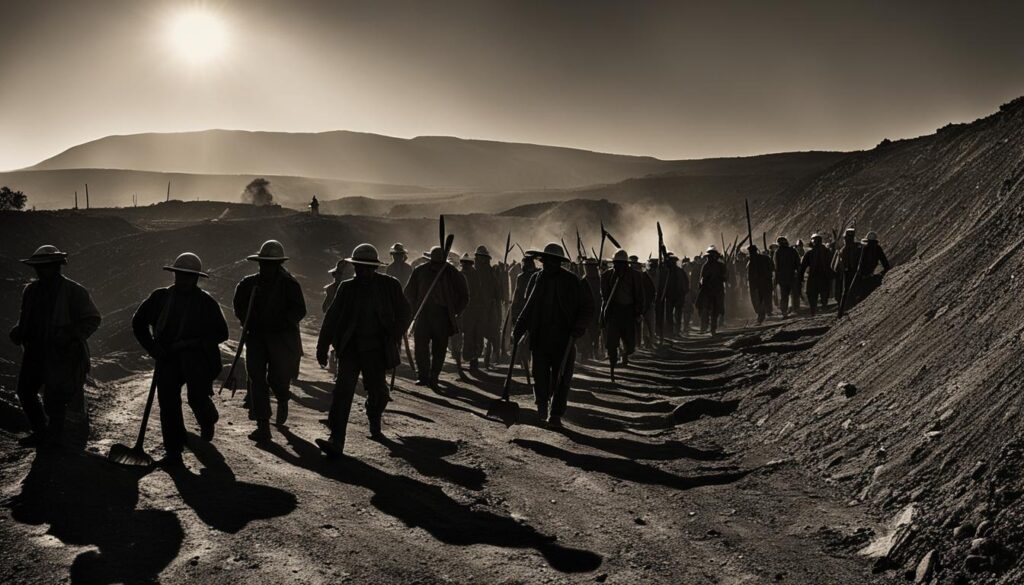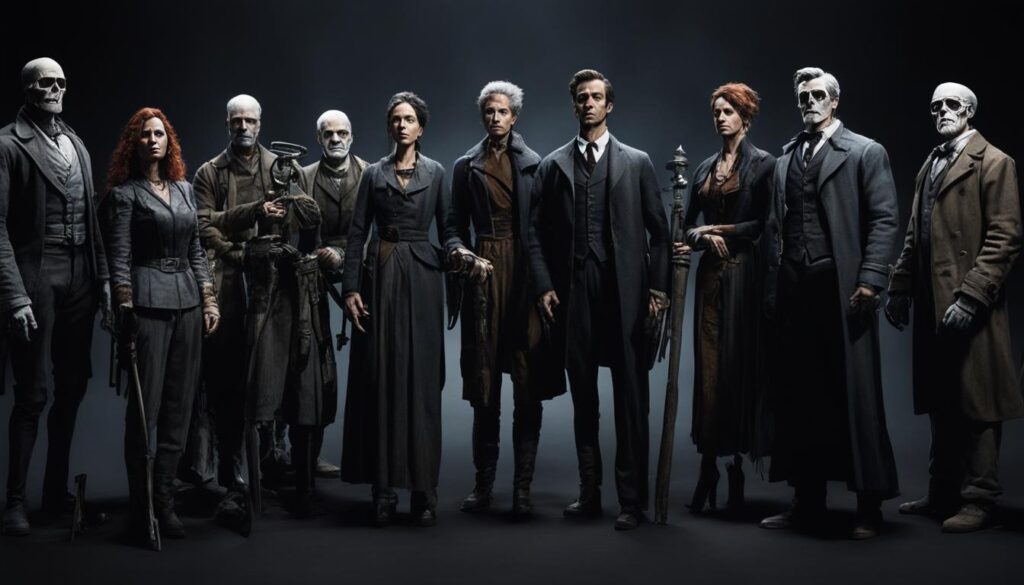In the fifth installment of the enthralling Crowner John Mystery series, titled “The Tinner’s Corpse,” acclaimed author Bernard Knight takes readers on a captivating journey into the world of medieval intrigue. Set in England during the Middle Ages, this book is a must-read for fans of historical crime fiction and anyone looking for a gripping tale filled with mystery and suspense.
In “The Tinner’s Corpse,” Knight showcases his exceptional storytelling skills as he weaves a complex and compelling narrative. The book introduces readers to Crowner John, the protagonist and a coroner with limited forensic knowledge, as he becomes entangled in a web of headless corpses, feuding tin miners, and enigmatic happenings surrounding the murders he investigates.
Knight crafts well-developed characters who pull readers deeper into their lives with their struggles and complexities. As Crowner John faces challenges from all directions, including interference from his brother-in-law, Sheriff Richard de Revelle, and the incompetence of his interim assistant, Theobald Fitz-Ivo, the reader is taken on a thrilling journey through medieval England.
This book offers a realistic portrayal of the justice system of the era, delving into the psyche of its protagonist as he questions his own abilities and wrestles with the weight of his responsibilities. While some readers may find the level of detail overwhelming and the ending unresolved, “The Tinner’s Corpse” sets the stage for the next exhilarating installment in the Crowner John Mystery series.
Key Takeaways:
- Experience medieval intrigue in Bernard Knight’s fifth Crowner John Mystery installment, “The Tinner’s Corpse.”
- Follow the well-developed characters as they navigate a web of headless corpses, feuding tin miners, and mysterious happenings.
- Witness the challenges faced by Crowner John in unraveling the motives behind the murders, given limited forensic knowledge.
- Explore the conflicts and complexities within medieval society through Knight’s realistic portrayal of justice and gender roles.
- Acknowledge the strengths and weaknesses of the book, as it paves the way for the next thrilling installment in the series.
Bernard Knight’s Crowner John Mystery Series
Bernard Knight, the author of “The Tinner’s Corpse,” is renowned for his captivating Crowner John Mystery series. With an average rating of 3.99 out of 5 and over 12,800 ratings on Goodreads, Knight’s books have garnered high praise from readers. This immersive series follows the life of Crowner John, a dedicated coroner in medieval England, on his relentless pursuit of justice amidst a backdrop of crimes and personal challenges.
The Crowner John Mystery series comprises a collection of gripping novels, including “The Sanctuary Seeker,” “The Poisoned Chalice,” “Crowner’s Quest,” “The Tinner’s Corpse,” “The Witch Hunter,” and many more. With each installment, Knight skillfully paints a vivid picture of historical accuracy while crafting engaging and intricate mysteries that keep readers hooked until the very end.
Readers who appreciate the rich tapestry of medieval fiction and the thrill of crime novels will find themselves immersed in Knight’s world, eagerly anticipating the next tantalizing mystery in the Crowner John series.
| Book Title | Rating |
|---|---|
| The Sanctuary Seeker | 4.1 |
| The Poisoned Chalice | 4.0 |
| Crowner’s Quest | 3.9 |
| The Tinner’s Corpse | 4.2 |
| The Witch Hunter | 4.3 |
Crowner John’s Investigation and the Tin Miners’ Conflict
In “The Tinner’s Corpse,” Crowner John delves into a murder investigation that becomes entangled with a conflict among tin miners. As the Lord Warden of the Tin Miners, Sheriff Richard de Revelle attempts to dissuade Crowner John from probing further into the deaths of the two miners. However, suspicions of financial impropriety arise due to Richard’s involvement in the pricing of tin. Undeterred, Crowner John pushes forward, determined to uncover the truth.
As the investigation progresses, Crowner John encounters resistance from Richard and finds himself navigating through a treacherous web of corruption and deceit. The tensions and dynamics within the tin mining community add depth and complexity to the plot, further fueling Crowner John’s determination to unveil the secrets hidden amidst the conflict.
“The Tinner’s Corpse” masterfully captures the clash between justice and power, as Crowner John fights against the odds to bring the truth to light.
The table below provides a glimpse into the intertwining elements of Crowner John’s murder investigation and the tin miners’ conflict:
| Crowner John’s Investigation | Tin Miners’ Conflict |
|---|---|
| Probing the deaths of two miners | Involvement of Sheriff Richard de Revelle |
| Suspicions of financial impropriety in the tin industry | Revelations about the pricing of tin |
| Resistance from Richard | Corruption and deceit within the tin mining community |
| Navigating through a web of intrigue | Tensions and conflicts within the community add complexity |
Through meticulous storytelling, Bernard Knight weaves a tale that explores the intricate dynamics between Crowner John’s murder investigation and the tin miners’ conflict, offering readers a captivating and immersive reading experience.

The Challenges of Forensic Medicine in Medieval Times
One of the challenges that Crowner John faces in “The Tinner’s Corpse” is the limited knowledge and resources available in the field of forensic medicine during medieval times. With pathology still in its nascent stages, John struggles to find answers to his questions surrounding the murders he is investigating. The lack of scientific advancements requires him to rely on his instincts, observation skills, and the scarce information available to piece together the puzzle. Bernard Knight adeptly highlights the limitations of forensic science in the era, offering readers a glimpse into the difficulties faced by investigators in historical crime fiction.
During the medieval period, the understanding of human anatomy and the pathology of diseases was limited. The practice of forensic medicine was in its nascent stages, posing significant challenges for investigators like Crowner John. The lack of scientific knowledge and resources hindered their ability to conduct thorough investigations and accurately determine the causes of death.
“Pathology was almost non-existent. No one really knew why people got sick or died. What we think of as forensic medicine today simply didn’t exist back then.”
This limitation forced Crowner John to rely heavily on his instincts and observation skills when examining crime scenes and bodies. He had to rely on external signs, such as wounds, bruises, and blood patterns, to draw conclusions about the cause of death. The absence of advanced forensic techniques, such as DNA analysis or toxicology testing, meant that the evidence available to John was often scarce and inconclusive.
Crowner John’s investigations in “The Tinner’s Corpse” highlight the challenges faced by medieval investigators in their pursuit of justice. The limitations of forensic medicine during that time demanded a unique blend of intuition, deduction, and perseverance.
The Importance of Observation and Intuition
In the absence of advanced scientific tools, observation and intuition played significant roles in Crowner John’s investigations. He carefully examined the crime scenes, paying attention to every detail, even the seemingly insignificant ones. By relying on his instincts and knowledge of human behavior, John was able to decipher hidden clues and make connections that others might have overlooked.
- Observation: Crowner John meticulously observed the condition of the body, the surrounding environment, and any potential signs of struggle or violence. His keen eye for detail allowed him to extract valuable information from the crime scenes.
- Intuition: The combination of experience and intuition guided Crowner John in his decision-making process. He relied on his gut instincts to guide his investigations and identify potential suspects and motives.
The challenges of forensic medicine in medieval times required investigators like Crowner John to think outside the box and rely on their innate abilities. It was a time when deductive reasoning and astute observation were paramount in solving crimes.
The Intriguing Characters of “The Tinner’s Corpse”
One of the strengths of “The Tinner’s Corpse” lies in Bernard Knight’s ability to develop intriguing and multidimensional characters. Crowner John, the protagonist, is portrayed as a complex and dedicated coroner, committed to uncovering the truth. His clashes with his brother-in-law, Sheriff Richard de Revelle, add tension and conflict to the story. Richard’s position as the Lord Warden of the Tin Miners and his dubious behavior further complicate John’s investigations. Knight paints a vivid picture of both primary and secondary characters, each with their own motivations and flaws, bringing depth and authenticity to the narrative.

Throughout “The Tinner’s Corpse,” Crowner John emerges as a compelling and multi-faceted character. His unwavering determination and unwavering commitment to justice make him a captivating protagonist. As a coroner, John possesses a unique perspective and the skills necessary to unravel the mysteries behind the headless corpses that haunt the tin mining community.
Sheriff Richard de Revelle, John’s brother-in-law, serves as an intriguing foil to our protagonist. As the Lord Warden of the Tin Miners, Richard’s motives and actions constantly challenge and complicate John’s investigations. His position of power and influence within the tin mining community creates tension and conflict, forcing John to navigate delicate relationships while seeking the truth.
Supported by a cast of well-crafted secondary characters, including feuding tin miners, challenging women, and mysterious individuals, Bernard Knight delivers a realistic portrayal of medieval society. The characters in “The Tinner’s Corpse” reflect the complexities of human nature, showcasing a range of motivations, flaws, and secrets that add depth and authenticity to the narrative.
In conclusion, the characters in “The Tinner’s Corpse” are intricately developed and contribute to the overall richness of the story. Crowner John’s dedication, Sheriff Richard de Revelle’s complexities, and the unique dynamics between them and the supporting cast make for a compelling and immersive reading experience. Bernard Knight’s ability to breathe life into his characters enhances the historical authenticity and intrigue of the Crowner John Mystery series.
The Role of Women in “The Tinner’s Corpse”
In “The Tinner’s Corpse,” Bernard Knight explores the role of women within the context of medieval society. The book sheds light on the challenges and restrictions imposed on women during that time, ultimately highlighting their limited agency and the pervasive misogyny prevalent in society.
Crowner John, the protagonist, interacts with various female characters throughout the narrative, some of whom defy societal norms and expectations placed upon them. Knight’s portrayal of these women sparks reflection on gender roles and empowerment, juxtaposing the limitations of the era with the characters’ determination to assert themselves.
Despite the oppressive social constraints they face, the women in “The Tinner’s Corpse” exhibit resilience and strength, demonstrating their ability to make their voices heard amidst a male-dominated society.
“Women in medieval society faced significant challenges and restrictions, but their determination and resilience shine through in Knight’s narrative, reminding us of the strength that exists even in the most trying circumstances.”
| Aspect | Challenges Faced by Women | Examples of Empowerment |
|---|---|---|
| Agency and Autonomy | – Limited decision-making power – Lack of control over their own lives – Absence of legal rights |
– Women challenging societal norms and defying expectations – Asserting their independence through actions and decisions |
| Education and Knowledge | – Restricted access to education – Lack of opportunity for intellectual growth |
– Women seeking knowledge through alternative means – Nurturing their intellect through hidden pursuits |
| Career and Occupations | – Limited career options outside traditional roles – Occupational discrimination and exclusion |
– Women taking on non-traditional roles – Flourishing in occupations typically dominated by men |
| Voice and Expression | – Suppression of opinions and perspectives – Silencing of female voices |
– Women challenging societal norms through expression – Asserting their opinions and advocating for their rights |
“Knight’s portrayal of women in ‘The Tinner’s Corpse’ not only highlights the challenges they faced but also celebrates their resilience and determination to reclaim their power and voice in a society that sought to suppress them.”
Themes of Struggle and Resilience in “The Tinner’s Corpse”
Themes of struggle and resilience permeate the pages of “The Tinner’s Corpse.” As the characters navigate through personal hardships, societal constraints, and the challenges of solving the murders at hand, their strength and determination are put to the test. Crowner John, in particular, finds himself grappling with the weight of his responsibilities and questioning his own ability to persevere in the face of adversity.
Bernard Knight skillfully explores the human capacity for resilience and determination, offering readers a nuanced depiction of the characters’ journeys. Through their struggles, readers are reminded of the indomitable spirit that propels individuals to overcome obstacles and emerge stronger in the end.
“The Tinner’s Corpse” showcases the triumph of the human spirit, the resilience that allows us to rise above adversity, and the perseverance required to confront life’s challenges head-on.
Diving Deep Within:
The book delves into the depths of the characters’ inner struggles, highlighting their resilience when faced with seemingly insurmountable odds. Whether it’s Crowner John’s determination to uncover the truth or the unwavering resolve of other key figures, the novel serves as a profound exploration of the human spirit.
- The characters confront personal hardships.
- Societal constraints test their resilience.
- Challenges in solving the murders push them to their limits.
Throughout the narrative, the characters’ struggles and their ability to endure showcase the triumph of the human spirit against all odds.
Resilience in Action:
- Crowner John questions his ability to fulfill his responsibilities.
- Other characters face their own challenges, both internal and external.
- Their determination and resilience propel the story forward in gripping fashion.
The triumph of the human spirit resonates with readers as they witness the characters’ unwavering determination to overcome their difficulties.
The image above beautifully captures the essence of struggle and resilience portrayed in “The Tinner’s Corpse,” symbolizing the challenges faced by the characters and their unwavering determination to overcome them.
| Themes | Description |
|---|---|
| Struggle | Characters encounter hardships and obstacles |
| Resilience | Characters demonstrate unwavering determination in the face of adversity |
| Adversity | Challenges and difficulties shape the characters’ journeys |
| Perseverance | Characters push through setbacks and maintain their resolve |
The table above provides a comprehensive overview of the key themes explored in “The Tinner’s Corpse,” illustrating the central concepts of struggle, resilience, adversity, and perseverance that drive the narrative forward.
Critiques of “The Tinner’s Corpse”
While “The Tinner’s Corpse” has received overall positive feedback, some readers have expressed certain criticisms of the book. One common critique centers around the level of detail, which some readers find overwhelming (insert critique keyword: critiques). Additionally, the unresolved ending has left certain readers unsatisfied (insert critique keyword: ending unresolved).
However, it is important to consider these critiques alongside the book’s strengths and the author’s intentions when forming an opinion (insert critique keyword: book review). It’s worth noting that the unresolved ending offers a glimpse into the reality that not all mysteries are neatly solved, reflecting a more realistic perspective on crime and justice (insert critique keyword: ending unresolved).
It is important to remember that critiques are subjective and that the book’s strengths may outweigh its weaknesses for many readers. The immersive storytelling, well-developed characters, and historical authenticity contribute to the overall appeal of “The Tinner’s Corpse” (insert critique keyword: book review).
Anticipation for the Next Installment: “The Grim Reaper”
Despite any critiques, readers who enjoyed “The Tinner’s Corpse” eagerly anticipate the next installment in the Crowner John Mystery series. Titled “The Grim Reaper,” the sixth book holds the promise of more thrilling mysteries, intriguing characters, and historical authenticity. Bernard Knight’s ability to weave captivating narratives within the medieval setting has garnered a dedicated following of fans who eagerly await the next chapter in Crowner John’s journey.
Image: Cover of “The Grim Reaper” – the next installment in the Crowner John Mystery series
Conclusion
In conclusion, “The Tinner’s Corpse” by Bernard Knight is a captivating book that transports readers into the world of medieval intrigue. With a skillful blend of well-developed characters, an engaging plot, and a richly depicted setting, Knight’s storytelling prowess shines through. Fans of historical crime fiction and the Crowner John Mystery series will be enthralled by this installment, eagerly turning the pages to unravel the twists and turns alongside Crowner John himself.
While every book has its strengths and weaknesses, “The Tinner’s Corpse” showcases Knight’s ability to immerse readers in the past, bringing a bygone era to life with meticulous attention to detail. The book holds the reader’s attention from start to finish, with its enthralling narrative and the complexities of Crowner John’s investigations. As the fifth book in the series, it keeps the momentum going, leaving readers eager for the next installment.
With “The Tinner’s Corpse,” Bernard Knight not only delivers a compelling book but also provides a glimpse into the challenges of medieval crime-solving, the limitations of forensic medicine, and the dynamics of a society governed by hierarchies and gender roles. This book serves as a testament to Knight’s ability to blend historical accuracy with gripping storytelling, ensuring a thoroughly immersive reading experience.



